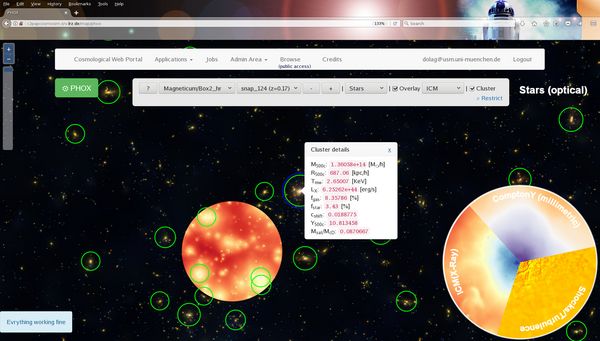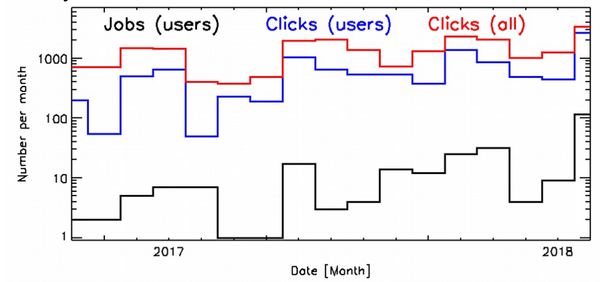ASTROPHYSICS
Magneticum Pathfinder: A Web Interface to Access Simulation Data
Principal Investigator:
Klaus Dolag
Affiliation:
Universitäts-Sternwarte, Ludwig-Maximilians-Universität München (Germany)
Local Project ID:
pr83li, pr86re
HPC Platform used:
SuperMUC of LRZ
Date published:
The outcome of a large set of cosmological, hydro-dynamical simulations from the project Magneticum now became made available to the general community through operating a cosmological simulation web portal. Users are able to access data products extracted from the simulations via a user-friendly web interface, browsing through visualizations of cosmological structures while guided by meta data queries helping to select galaxy clusters and galaxy groups of interest. Several services are available for the users: (I) ClusterInspect; (II) SimCut (raw data access); (III) Smac (2D maps); (IV) Phox (virtual X-ray observations, taking the specifications of various, existing and future X-ray telescopes into account.
Introduction
Within modern cosmology, the Big Bang marks the beginning of the universe and the creation of matter, space and time about 13.8 billion years ago. Since then, the visible structures of the cosmos have developed: billions of galaxies which bind gas, dust, stars and planets with gravity and host supermassive black holes in their centres. But how could these visible structures have formed from the Universe’s initial conditions?
To answer this question, theoretical astrophysicists carry out large, cosmological simulations. They transform our knowledge about the physical processes which drive the formation of our universe into models and simulate the resulting evolution of our universe across a large range of spacial scales and over billions of years. To be comparable to ongoing and future cosmological surveys, such theoretical models have to cover very large volumes, especially to host the rarest, most massive galaxy clusters expected to be the lighthouses of structure formation detectable already at early times (e.g. at high redshifts).
While the Universe makes its transition from dark matter dominated to dark energy dominated (i.e. accelerated expansion), the objects which form within it make their transition from young, dynamically active and star formation driven systems to more relaxed and equilibrated systems observed at late time (e.g. low redshifts). Especially here, theoretical models in form of complex, hydrodynamical cosmological simulations are needed to disentangle the internal evolution of clusters of galaxies with respect to the evolution of the cosmological background. Such simulations will be essential to interpret the outstanding discoveries expected from upcoming surveys.
To make the outcome of such large cosmological hydrodynamics simulations available to a broad scientific community, LRZ in cooperation with experts from C2PAP (the Excellence Cluster Universe's datacentre) has now opened access to the Cosmological Web Portal [1], which now has already more than 150 registered users (see figure 1 for a usage statistics). In a first step, two of the largest simulation sets form the Magneticum Pathfinder Project [2] where made public.
Challenges of the Web Portal
The Web portal is based on a multi-layer structure, see [3,4] for more details. Between those layers, data and processes flow over the web portal with its web interface, several databases, the backend within the job control layer, the compute cluster (where the analysis tools are actually executed) and the storage system (where the raw simulation data are stored). The need for a separation between the web interface and the backend arises from both the necessity of users to run personalized jobs on raw data, managed by a job scheduler of the compute cluster and the protection of the data from unauthorized access.
As compute layer, currently the C2PAP compute cluster, operated by the Excellence cluster Origin and Structure of the Universe [5] is used while for the HPC storage we make use of the new Data Science Storage service at LRZ. All other processes are virtualised using the LRZ machines. Almost all parts of the implementation is based on common packages and publicly available libraries, except the core of the backend, which is a customized component tailored for the data flows, job requests and specific needs of the used scientific data analysis software. All services are based on standard post-processing tools as used in scientific analysis of such simulations.
The Web Interface
The visual frontend allows to explore the cosmological structures within the simulation, based on panning through and zooming into high resolution, 256 megapixel size images which are available for numerous outputs of the different simulations. A special layer-spy option can be used to show a second, smaller, visualization within a lens which can be moved freely over the whole image and moving the layer spy over the visible objects reveals immediately and intuitively the connection between the different components.

Figure 2: In the visual front end (here showing the Magneticum/Box2b/hr simulation at z=0.17) the stellar component is used as the basic, background visualization. The layer-spy option allows to dynamically overlap a movable lens with different other visualisation. All objects chosen in the "Restrict" menu are marked with green circles. The blue circle marks the currently chosen cluster, the pop-up info window shows its basic properties. The overlay “pie chart” in the lower right corner shows examples of different visualizations which can be chosen [1].
Copyright: LMU MünchenServices currently available
There are several services available with the web interface which are designed to complete the interactive exploration of the simulation, to explore and select interesting objects and to allow the user to obtain information based on unprocessed simulation data or virtual observations of selected objects.
The ClusterFind service operates on the stored meta data and returns a list of objects matching the given properties. It shows the resulting list of objects in form of a table and additionally allows to produce histograms or scatter plots from any combination of columns within the result table. In addition, the produced table can be exported as CSV-table and individual objects can be selected by clicking on the table entry or the data points in the plot.
The ClusterInspect service works similar to the ClusterFind, except that, once an object (e.g. galaxy cluster or group) is selected, the generated table displays the properties of all member galaxies of the cluster/group. The interactive plotting tool allows then to visualize any galaxy property from the table in the same way as described above.
The SimCut service allows users to directly obtain the unprocessed simulation data for the selected object. These data are returned in the original simulation output format. Therefore, the user may analyse the data in the same way as he would do for his own simulations.
The Smac service allows the user to obtain 2D maps of integrate physical quantities along the line of sight. Currently, the service allows to produce column densities for the gas component or for the entire matter, the massweighted temperature bolometric X-ray surface brightness and the thermal or kinetic SZ maps. The maps are returned in standard FITS files.
The Phox service allows to perform synthetic X-ray observations of the ICM and AGN component of selected galaxy clusters. Here the user can choose among current and future X-ray instruments to make use of the actual specifications of these instruments. An idealized list of Xray photons for the chosen instrument is returned. To produce an even more realistic result, the user can additionally request a detailed instrument simulation based on special software available for the individual Xray satellite missions. All result are provided in form of a so called event file in the FIT format, which is identical (beside some keywords in the headers) to what would be obtained from a real observation.
On-going Research and Outlook
The Magneticum research collaboration will continue to integrate more simulations into the web interface and also works on extending the services towards detailed analysis of individual galaxies.
Researchers
Veronica Biffi, Nicolay J. Hammer, Alexey Krukau, Margarita Petkova, Antonio Ragagnin
Project Partners
C2PAP Universe Cluster, Leibniz Supercomputing Centre (LRZ)
References and Links
[1] https://c2papcosmosim.uc.lrz.de/
[3] Ragagnin, A., Dolag, K., Biffi, V., Cadolle Bel, M., Hammer, N.J., Krukau, A., Petkova, M., Steinborn, D.: “A web portal for hydrodynamical, cosmological simulations”, 2017, A&C, 20, 52, https://ui.adsabs.harvard.edu/abs/2017A%26C....20...52R/abstract
[4] http://inside.hlrs.de/editions/17spring.html#the-cosmological-web-portal-has-gone-online-at-lrz
Scientific Contact:
Klaus Dolag
Ludwig-Maximilians-Universität München
Universitäts-Sternwarte
Scheinerstr. 1, D-81679 München (Germany)
e-mail: kdolag [@] MPA-Garching.MPG.DE
NOTE: This report was first published in the book "High Performance Computing in Science and Engineering – Garching/Munich 2018".
LRZ project IDs: pr83li, pr86re
May 2019
